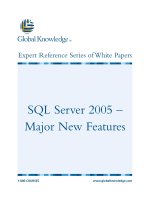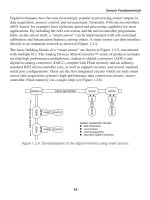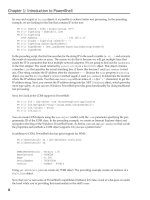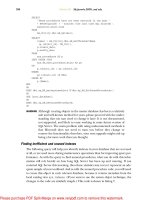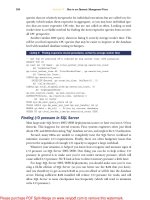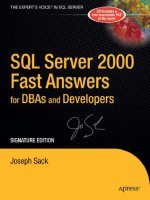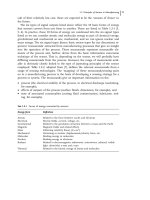Tài liệu SQL Puzzles & Answers- P2 pptx
Bạn đang xem bản rút gọn của tài liệu. Xem và tải ngay bản đầy đủ của tài liệu tại đây (378.65 KB, 40 trang )
22 PUZZLE 6 HOTEL RESERVATIONS
Answer #2
Another solution is to redesign the table, giving a row for each day and
each room, thus:
CREATE TABLE Hotel
(room_nbr INTEGER NOT NULL,
occupy_date DATE NOT NULL,
guest_name CHAR(30) NOT NULL,
PRIMARY KEY (room_nbr, occupy_date, guest_name));
This does not need any check clauses, but it can take up disk space
and add some redundancy. Given cheap storage today, this might not be
a problem, but redundancy always is. You will also need to find a way in
the
INSERT statements to be sure that you put in all the room days
without any gaps.
As an aside, in full SQL-92 you will have an
OVERLAPS predicate that
tests to see if two time intervals overlap a temporal version of the
BETWEEN predicate currently in SQL implementations. Only a few
products have implemented it so far.
Answer #3
Lothar Flatz, an instructor for Oracle Software Switzerland, made the
objection that the clause “
H1.arrival_date BETWEEN
H2.arrival_date AND H2.depatures
” does not allow for a guest name
to arrive the same day another guest name leaves.
Since Oracle cannot put subqueries into
CHECK() constraints and
triggers would not be possible because of the mutating table problem, he
used a
VIEW that has a WITH CHECK OPTION to enforce the occupancy
constraints:
CREATE VIEW HotelStays (room_nbr, arrival_date,
departure_date, guest_name)
AS SELECT room_nbr, arrival_date, departure_date,
guest_name
FROM Hotel AS H1
WHERE NOT EXISTS
(SELECT *
FROM Hotel AS H2
WHERE H1.room_nbr = H2.room_nbr
AND H2.arrival_date < H1.arrival_date
Please purchase PDF Split-Merge on www.verypdf.com to remove this watermark.
PUZZLE 6 HOTEL RESERVATIONS 23
AND H1.arrival_date < H2.departure_date)
WITH CHECK OPTION;
For example,
INSERT INTO HotelStays
VALUES (1, '2008-01-01', '2008-01-03', 'Coe');
COMMIT;
INSERT INTO HotelStays
VALUES (1, '2008-01-03', '2008-01-05', 'Doe');
will give a WITH CHECK OPTION clause violation on the second INSERT
INTO
statement. This is a good trick for getting table-level constraints in
a table on products without full SQL-92 features.
Please purchase PDF Split-Merge on www.verypdf.com to remove this watermark.
24 PUZZLE 7 KEEPING A PORTFOLIO
PUZZLE
7 KEEPING A PORTFOLIO
Steve Tilson sent this problem to me in November 1995:
I have a puzzle for you. Perhaps I cannot see the forest for the trees
here, but this seems like a real challenge to solve in an elegant manner
that does not result in numerous circular references.
Although this puzzle seems to be an entire system, my question is
whether or not there is a way to eliminate the apparent circular
references within the table design phase.
Let’s say you must keep track of Portfolios in an organization for
lookup or recall. There are various attributes attached, but only certain
items are pertinent to the puzzle:
CREATE TABLE Portfolios
(file_id INTEGER NOT NULL PRIMARY KEY,
issue_date DATE NOT NULL,
superseded_file_id INTEGER NOT NULL REFERENCES Portfolios
(file_id),
supersedes_file_id INTEGER NOT NULL REFERENCES
Portfolios(file_id));
Here is the puzzle:
You need to keep track of which portfolio superseded the current
portfolio.
You need to keep track of which portfolio this portfolio has super-
seded.
You need to be able to reinstate a portfolio (which has the effect of
superseding a portfolio or portfolio chain, which results in a circu-
lar reference).
You can track the dates by virtue of the issue_date, but another
thorny issue results if a portfolio is reinstated!
You need to be able to SELECT the most current portfolio regard-
less of the portfolio in a
SELECT statement.
You need to be able to reproduce an audit trail for a chain of
documents.
Please purchase PDF Split-Merge on www.verypdf.com to remove this watermark.
PUZZLE 7 KEEPING A PORTFOLIO 25
Answer #1
Steve is still thinking in terms of pointer chains and procedural
languages. Shame on him! We know this is a problem that deals with
ordinal numbering, because we have the give-away words “successor”
and “predecessor” in the specification. Let’s apply what we know about
nested sets instead.
First, create a table to hold all the information on each file:
CREATE TABLE Portfolios
(file_id INTEGER NOT NULL PRIMARY KEY,
other_stuff );
Then create a table to hold the succession of the documents, with two
special columns, chain and next, in it.
CREATE TABLE Succession
(chain INTEGER NOT NULL,
next INTEGER DEFAULT 0 NOT NULL CHECK (next >= 0),
file_id INTEGER NOT NULL REFERENCES Portfolios(file_id),
suc_date NOT NULL,
PRIMARY KEY(chain, next));
Imagine that the original document is the zero point on a line.
The next document that supersedes
_file_id is a circle drawn
around the point. The third document in the chain of succession is a
second circle drawn around the first circle, and so forth. We show these
nested sets with the next value, flattening the circles onto the number
line starting at zero.
You have to create the new document row in Portfolios, then the
succession table entry. The value of next in the successor is one greater
than the highest next value in the chain. Nested sets!!
Here is some sample data where a chain of ‘22?’ and ‘32?’ documents
are superseded by a single document, 999.
CREATE TABLE Portfolios
(file_id INTEGER NOT NULL PRIMARY KEY,
stuff CHAR(15) NOT NULL);
INSERT INTO Portfolios
VALUES (222, 'stuff'),
Please purchase PDF Split-Merge on www.verypdf.com to remove this watermark.
26 PUZZLE 7 KEEPING A PORTFOLIO
(223, 'old stuff'),
(224, 'new stuff'),
(225, 'borrowed stuff'),
(322, 'blue stuff'),
(323, 'purple stuff'),
(324, 'red stuff'),
(325, 'green stuff'),
(999, 'yellow stuff');
CREATE TABLE Succession
(chain INTEGER NOT NULL,
next INTEGER NOT NULL,
file_id INTEGER NOT NULL REFERENCES Portfolios(file_id),
suc_date NOT NULL,
PRIMARY KEY(chain, next));
INSERT INTO Succession
VALUES (1, 0, 222, '2007-11-01'),
(1, 1, 223, '2007-11-02'),
(1, 2, 224, '2007-11-04'),
(1, 3, 225, '2007-11-05'),
(1, 4, 999, '2007-11-25'),
(2, 0, 322, '2007-11-01'),
(2, 1, 323, '2007-11-02'),
(2, 2, 324, '2007-11-04'),
(2, 3, 322, '2007-11-05'),
(2, 4, 323, '2007-11-12'),
(2, 5, 999, '2007-11-25');
To answer your queries:
You need to be able to SELECT the most current portfolio regard-
less of the portfolio in a
SELECT statement.
SELECT DISTINCT P1.file_id, stuff, suc_date
FROM Portfolios AS P1, Succession AS S1
WHERE P1.file_id = S1.file_id
AND next = (SELECT MAX(next)
FROM Succession AS S2
WHERE S1.chain= S2.chain);
Please purchase PDF Split-Merge on www.verypdf.com to remove this watermark.
PUZZLE 7 KEEPING A PORTFOLIO 27
I have to use the SELECT DISTINCT option in case two or more chains
were superseded by a single document.
You need to be able to reproduce an audit trail for a chain of docu-
ments.
SELECT chain, next, P1.file_id, stuff, suc_date
FROM Portfolios AS P1, Succession AS S1
WHERE S1.file_id = P1.file_id
ORDER BY chain, next;
You need to keep track of which portfolio superseded this portfolio.
SELECT S1.file_id, ' superseded ',
S2.file_id, ' on ', S2.suc_date
FROM Succession AS S1, Succession AS S2
WHERE S1.chain = S2.chain
AND S1.next = S2.next + 1
AND S1.file_id = :my_file_id; remove for all
portfolios
You need to be able to reinstate a portfolio, which has the effect of
superseding a portfolio or portfolio chain, which results in a circu-
lar reference.
BEGIN
Create a row for the new document
INSERT INTO Portfolios VALUES (1000, 'sticky stuff');
adds new_file_id to chain with :old_file_id anywhere in
it.
INSERT INTO Succession (chain, next, file_id, suc_date)
VALUES ((SELECT DISTINCT chain
FROM Succession AS S1
WHERE S1.file_id = :old_file_id),
(SELECT MAX(next) + 1
FROM Succession AS S1
WHERE S1.chain = (SELECT DISTINCT chain
FROM Succession AS S2
WHERE file_id = :my_file_id)),
:new_file_id, :new_suc_date);
END;
Please purchase PDF Split-Merge on www.verypdf.com to remove this watermark.
28 PUZZLE 7 KEEPING A PORTFOLIO
The problem here is that I allowed for a single file to supersede more
than one existing file and for more than one file to supersede a single
existing file. My chains are not really all that linear. This code blows up if
:old_file_id is in more than one chain. You can fix it by asking for the
chain number or the file_id of the document that the new file supersedes
_file_id, but the SQL is ugly and I don’t have time to work it out right
now. You can try it.
You can track the dates by virtue of the issue date, but another
thorny issue results if a portfolio is reinstated!
No big deal with this schema. Do a
SELECT on any particular file_id
and look at the dates and next column to get the chain of events. You did
not say if the succession date column values have to be in increasing
order, along with the next column values. Is that true? If so, we need to
add another
CHECK() clause to handle this.
Please purchase PDF Split-Merge on www.verypdf.com to remove this watermark.
PUZZLE 8 SCHEDULING PRINTERS 29
PUZZLE
8 SCHEDULING PRINTERS
Yogesh Chacha ran into a problem and sent it to me on CompuServe on
September 12, 1996. Users in his shop usually end up using the wrong
printer for printout, thus they decided to include a new table in the
system that will derive the correct printer for each user at runtime. Their
table looked like this:
CREATE TABLE PrinterControl
(user_id CHAR(10), null means free printer
printer_name CHAR(4) NOT NULL PRIMARY KEY,
printer_description CHAR(40) NOT NULL);
The rules of operation are that:
1. If the user has an entry in the table, he will pick the
corresponding printer_name.
2. If the user is not in the table then, he is supposed to use one of
the printers whose
user_id is NULL.
Now, consider the following example:
PrinterControl
user_id printer_name printer_description
========================================================
'chacha' 'LPT1' 'First floor's printer'
'lee' 'LPT2' 'Second floor's printer'
'thomas' 'LPT3' 'Third floor's printer'
NULL 'LPT4' 'Common printer for new user'
NULL 'LPT5' 'Common printer for new user'
When 'chacha' executes the report he is entitled to use only LPT1,
whereas a user named
'celko' is expected to use either LPT4 or LPT5.
In the first case, a simple query can pull out one row and it works fine; in
the second case, you get two rows and cannot use that result.
Can you come up with a one-query solution?
Please purchase PDF Split-Merge on www.verypdf.com to remove this watermark.
30 PUZZLE 8 SCHEDULING PRINTERS
Answer #1
I would answer that the problem is in the data. Look at the user_id
column. The name tells you that it should be unique, but it has multiple
NULLs in it. There is also another problem in the real world; you want to
balance the printer loads between LPT4 and LPT5, so that one of them is
not overused.
Do not write a fancy query; change the table:
CREATE TABLE PrinterControl
(user_id_start CHAR(10) NOT NULL,
user_id_finish CHAR(10) NOT NULL,
printer_name CHAR(4) NOT NULL,
printer_description CHAR(40) NOT NULL
PRIMARY KEY (user_id_start, user_id_finish));
Now, consider the following example:
PrinterControl
user_id_start user_id_finish printer_name
printer_description
==========================================================
'chacha' 'chacha' 'LPT1' 'First floor's printer'
'lee' 'lee' 'LPT2' 'Second floor's printer'
'thomas' 'thomas' 'LPT3' 'Third floor's printer'
'aaaaaaaa' 'mzzzzzzzz' 'LPT4' 'Common printer #1 '
'naaaaaaa' 'zzzzzzzz' 'LPT5' 'Common printer #2'
The query then becomes:
SELECT MIN(printer_name)
FROM PrinterControl
WHERE :my_id BETWEEN user_id_start AND user_id_finish;
The trick is in the start and finish values, which partition the range of
possible strings between '
aaa ' and 'zzz ' any way you wish. The
'
celko' user id qualified only for LPT4 because it falls alphabetically
within that range of strings. A user '
norman' is qualified only for LPT5.
Careful choice of these ranges will allow you to distribute the printer
loads evenly if you know what the user ids are going to be like.
Please purchase PDF Split-Merge on www.verypdf.com to remove this watermark.
PUZZLE 8 SCHEDULING PRINTERS 31
I have assumed the common printers always will have higher LPT
numbers. When '
chacha' goes to this table, he will get a result set of
(LPT1, LPT4), and then pick the minimum value, LPT1, from it. A
smart optimizer should be able to use the
PRIMARY KEY index to speed
up the query.
Answer #2
Richard Romley came up with a different solution:
SELECT COALESCE(MIN(printer_name),
(SELECT MIN(printer_name)
FROM PrinterControl AS P2
WHERE user_id IS NULL))
FROM PrinterControl AS P1
WHERE user_id = :user_id;
This is trickier than it looks. You go to the outer WHERE clause with
user_id = 'celko', an unregistered user, so you would think that you
don’t get any rows from the P1 copy of PrinterControl.
This is not true. While a query like:
SELECT col
FROM SomeTable
WHERE 1 = 2;
will return no rows, a query like:
SELECT MAX(col)
FROM SomeTable
WHERE 1 = 2;
will return one row containing one column (col) that is NULL. This is a
funny characteristic of the aggregate functions on empty sets. Therefore,
SELECT COALESCE(MAX(col), something_else)
FROM SomeTable
WHERE 1 = 2;
will work. The WHERE clause is used only to resolve MAX(col) and not to
determine whether or not to return rows; that is the job of the
SELECT
Please purchase PDF Split-Merge on www.verypdf.com to remove this watermark.
32 PUZZLE 8 SCHEDULING PRINTERS
clause. The aggregate MAX(col) will be NULL and will get returned.
Therefore, the
COALESCE() will work.
The bad news is that when I get back a row, this query is going to
return the same printer over and over, instead of distributing the
workload over all the unassigned printers. You can add an update
statement to replace the
NULL with the guest user, so that the next printer
will be used.
Answer #3
This can be fixed with a simple repair:
SELECT COALESCE(MIN(printer_name),
(SELECT CASE
WHEN :user_id < 'n'
THEN 'LPT4'
ELSE 'LPT5' END
FROM PrinterControl
WHERE user_id IS NULL))
FROM printer_control
WHERE user_id = :user_id;
The flaw with this answer is that all common printer rows are being
handled in the query, so you don’t need them in the table at all. If you
went that route, you would just remove everything after the
CASE
statement from the second query above. This would mean, however, that
you never record information about the printers in the database. If you
drop or add printers, you have to change the query, not the database
where you are supposed to keep this information.
Answer #4
We can change the table design again to hold a flag for the type of
printer:
CREATE TABLE PrinterControl
(user_id CHAR(10), null means free printer
printer_name CHAR(4) NOT NULL PRIMARY KEY,
assignable_flag CHAR(1) DEFAULT ‘Y’ NOT NULL
CHECK (assignable_flag IN (‘Y’, ‘N’),
printer_description CHAR(40) NOT NULL);
Please purchase PDF Split-Merge on www.verypdf.com to remove this watermark.
PUZZLE 8 SCHEDULING PRINTERS 33
We then update the table with:
UPDATE PrinterControl
SET user_id = :guest_id
WHERE printer_name
= (SELECT MIN(printer_name)
FROM PrinterControl
WHERE assignable_flag = ‘Y’
AND user_id IS NULL);
Then you need to clear out the guest users at some point in time.
UPDATE PrinterControl
SET user_id = NULL
WHERE assignable_flag = ‘Y’;
Please purchase PDF Split-Merge on www.verypdf.com to remove this watermark.
34 PUZZLE 9 AVAILABLE SEATS
PUZZLE
9 AVAILABLE SEATS
You have a restaurant with 1,000 seats. Whenever a waiter puts
someone at a seat, he logs it in a table of seats (I was going to say “table
of tables” and make this impossible to read). Likewise, when a guest
finishes a meal, you remove the guest’s seat number. You want to write a
query to produce a list of the available seats in the restaurant, set up in
blocks by their starting and ending seat numbers. Oh yes, the gimmick
is that the database resides on a personal digital assistant and not a
mainframe computer.
As part of the exercise, you must do this with the smallest amount of
storage possible. Assume each seat number is an integer.
The first thought is to add a (free/occupied) flag column next to the
seat-number column. The available seating query would be based on the
flag. This would be 1,000 rows of one integer and one character for the
whole restaurant and would work pretty well, but we have that minimal
storage requirement. Darn!
Answer #1
The flag can be represented by a plus or minus on the seat number itself
to save the extra column, but this is very bad relational practice; two
attributes are being collapsed into one column. But it does keep us at
1,000 rows.
UPDATE Seats
SET seat_nbr = -seat_nbr
WHERE seat_nbr = :my_seat;
The same update statement can be used to put back into the Available
list, and a “
SET seat_nbr = ABS(seat_nbr)” will reset the restaurant at
closing time.
Answer #2
The second thought is to create a second table with a single column of
occupied seating and to move numbers between the occupied and
available tables. That would require a total of 1,000 rows in both tables,
which is a little weird, but it leads to the next answer.
Please purchase PDF Split-Merge on www.verypdf.com to remove this watermark.
PUZZLE 9 AVAILABLE SEATS 35
Answer #3
Instead, we can use a single table and create seats 0 through 1,001 (0
and 1,001 do not really exist and are never assigned to a customer. They
act as sentries on the edge of the real seating to make the code easier).
Delete each seat from the table as it is occupied and insert it back when it
is free again. The Restaurant table can get as small as the two dummy
rows if all the seating is taken, but no bigger than 1,002 rows (2,004
bytes) if the house is empty.
This VIEW will find the first seat in a gap of open seats:
CREATE VIEW Firstseat (seat)
AS SELECT (seat + 1)
FROM Restaurant
WHERE (seat + 1) NOT IN
(SELECT seat FROM Restaurant)
AND (seat + 1) < 1001;
Likewise, this VIEW finds the last seat in a gap of open seats:
CREATE VIEW Lastseat (seat)
AS SELECT (seat - 1)
FROM Restaurant
WHERE (seat - 1) NOT IN
(SELECT seat FROM Restaurant)
AND (seat - 1) > 0;
Now, use these two VIEWs to show the blocks of empty seats:
SELECT F1.seat AS start, L1.seat AS finish.
((L1.seat - F1.seat) + 1) AS available
FROM Firstseat AS F1, Lastseat AS L1
WHERE L1.seat = (SELECT MIN(L2.seat)
FROM Lastseat AS L2
WHERE F1.seat <= L2.seat);
This query will also tell you how many available seats are in each
block, a fact that could be handy for a waiter to know when seating
groups. It is left as an exercise to the reader to write this as a single query
without
VIEWs.
Please purchase PDF Split-Merge on www.verypdf.com to remove this watermark.
36 PUZZLE 9 AVAILABLE SEATS
Answer #4
Richard Romley combined the VIEWs into one query using the extended
table with the rows 0 and 1,001 included:
SELECT (R1.seat + 1) AS start,
(MIN(R2.seat) - 1) AS finish
FROM Restaurant AS R1
INNER JOIN
Restaurant AS R2
ON R2.seat > R1.seat
GROUP BY R1.seat
HAVING (R1.seat + 1) < MIN(R2.seat);
Answer #5
For variety you can use the new SQL-99 OLAP functions and get a bit
more information:
SELECT X.seat_nbr, X.rn,
(rn-seat_nbr) AS available_seat_cnt
FROM (SELECT seat_nbr,
ROW_NUMBER()
OVER (ORDER BY seat_nbr)
FROM Restaurant) AS X(seat_nbr, rn)
WHERE rn <> seat_nbr;
The available_seat_cnt is the number of open seats less than the
seat_nbr. This could be useful if the restaurant is broken into sections
in some way.
Please purchase PDF Split-Merge on www.verypdf.com to remove this watermark.
PUZZLE 10 WAGES OF SIN 37
PUZZLE
10 WAGES OF SIN
Luke Tymowski, a Canadian programmer, posted an interesting problem
on the MS ACCESS Forum on CompuServe in November 1994. He was
working on a pension fund problem. In SQL-92, the table involved
would look like this:
CREATE TABLE Pensions
(sin CHAR(10) NOT NULL,
pen_year INTEGER NOT NULL,
month_cnt INTEGER DEFAULT 0 NOT NULL
CHECK (month_cnt BETWEEN 0 AND 12),
earnings DECIMAL (8,2) DEFAULT 0.00 NOT NULL);
The SIN column is the Social Insurance Number, which is something
like the Social Security Number (SSN) used in the United States to
identify taxpayers. The pen_year column is the calendar year of the
pension, the
month_cnt column is the number of months in that year the
person worked, and earnings is the person’s total earnings for the year.
The problem is to find the total earnings of each employee for the
most recent 60 months of month_cnt in consecutive years. This number
is used to compute the employee’s pension. The shortest period going
back could be 5 years, with 12 months in each year applying to the total
month_cnt. The longest period could be 60 years, with 1 month in each
year. Some people might work four years and not the fifth, and thus not
qualify for a pension at all.
The reason this is a beast to solve is that “most recent” and
“consecutive” are hard to write in SQL.
HINT: For each employee in each year, insert a row even in the years in which
the employee did not work. It not only makes the query easier, but you also
have a record to update when you get in new information.
Answer #1
This query will get me the starting and ending years of consecutive
periods where (1) the employee worked (i.e., month_cnt greater than 0
months) and (2) the month_cnt totaled 60 or more.
Please purchase PDF Split-Merge on www.verypdf.com to remove this watermark.
38 PUZZLE 10 WAGES OF SIN
CREATE VIEW PenPeriods (sin, start_year, end_year,
earnings_tot)
AS SELECT P0.sin, P0.pen_year, P1.pen_year,
(SELECT SUM (earnings) total earnings for period
FROM Pensions AS P2
WHERE P2.sin = P0.sin
AND P2.pen_year BETWEEN P0.pen_year AND P1.pen_year)
FROM Pensions AS P0, Pensions AS P1
WHERE P1.sin = P0.sin self-join to make intervals
AND P1.pen_year >= (P0.pen_year - 4) why sooner?
AND 0 < ALL (SELECT month_cnt consecutive months
FROM Pensions AS P3
WHERE P3.sin = P0.sin
AND P3.pen_year
BETWEEN P0.pen_year AND P1.pen_year)
AND 60 <= (SELECT SUM (month_cnt) total more than
60
FROM Pensions AS P4
WHERE P4.sin = P0.sin
AND P4.pen_year
BETWEEN P0.pen_year AND
P1.pen_year);
The subquery expression in the SELECT list is a SQL-92 trick, but a
number of products already have it.
The gimmick is that this will give you all the periods of 60 months or
more. What we really want is the most recent end_year. I would handle
this with the pension period view I just defined and a
MAX(end_year)
predicate:
SELECT *
FROM PenPeriods AS P0
WHERE end_year = (SELECT MAX(end_year)
FROM PenPeriods AS P1
WHERE P1.sin = P0.sin);
I can handle that with some ugly HAVING clauses in SQL-92, I could
combine both those subquery predicates with an
EXISTS clause, and so
on.
As an exercise, you can try to add another predicate to the final
subquery that says there does not exist a year between
P0.pen_year and
Please purchase PDF Split-Merge on www.verypdf.com to remove this watermark.
PUZZLE 10 WAGES OF SIN 39
P1.pen_year that is greater than the P4.pen_year and still gives a total
of 60 or more consecutive months.
Answer #2
Most of the improved solutions I got via CompuServe were based on my
original answer. However, Richard Romley sent in the best one and used
a completely different approach. His answer used three copies of the
Pensions table, ordered in time as
P0, P1, and P2.
SELECT P0.sin,
P0.pen_year AS start_year,
P2.pen_year AS end_year,
SUM (P1.earnings)
FROM Pensions AS P0, Pensions AS P1, Pensions AS P2
WHERE P0.month_cnt > 0
AND P1.month_cnt > 0
AND P2.month_cnt > 0
AND P0.sin = P1.sin
AND P0.sin = P2.sin
AND P0.pen_year BETWEEN P2.pen_year-59 AND (P2.pen_year -
4)
AND P1.pen_year BETWEEN P0.pen_year AND P2.pen_year
GROUP BY P0.sin, P0.pen_year, P2.pen_year
HAVING SUM (P1.month_cnt) >= 60
AND (P2.pen_year - P0.pen_year) = (COUNT (*) - 1);
Mr. Romley wrote: “This problem would have been easier if there
were no rows allowed with (
month_cnt = 0). I had to waste three WHERE
clauses just to filter them out!” Another example of how a better data
design would have made life easier!
The outstanding parts of this answer are the use of the
BETWEEN
predicate to look at durations in the range of 5 to 60 years (the minimum
and maximum time needed to acquire 60 months of
month_cnt) and the
use of grouping columns in the last expression in the
HAVING clause to
guarantee consecutive years.
When I ran this query on WATCOM SQL 4.0, the query planner
estimate was four times greater for Mr. Romley’s solution than for my
original solution, but his actually ran faster. I would guess that the plan
estimation is being fooled by the three-way self-joins, which are usually
very expensive.
Please purchase PDF Split-Merge on www.verypdf.com to remove this watermark.
40 PUZZLE 10 WAGES OF SIN
Answer #3
In 1999, Dzavid Dautbegovic sent in the following response to the first
edition of this book:
“Both solutions are excellent in their own way (your SQL-92,
Richard’s SQL-89). I must confess that my solution is too complicated
and totally inelegant but much closer to Richard’s answer. For me the
biggest problem was to get sum of earnings in the first position. But I
think that you need to change your second select if you want most recent
end_year and only one solution per SIN. For this to work, we need to
make a
VIEW from Richard’s solution.”
SELECT P0.sin, P0.end_year,
MAX(P0.start_year) AS laststart_year,
MIN(P0.sumofearnings) AS minearnings,
MIN(P0.sumofmonth_cnt) AS minmonth_cnt,
MIN(P0.start_year) AS firststart_year,
MAX(P0.sumofearnings) AS maxearnings,
MAX(P0.sumofmonth_cnt) AS maxmonth_cnt
FROM PensionsView AS P0
WHERE end_year = (SELECT MAX(end_year)
FROM Pensions AS P1
WHERE P1.sin = P0.sin)
GROUP BY P0.sin, P0.end_year;
Answer #4
Phil Sherman in April 2006 pointed out that this is an interesting
problem because the answer should almost always be indeterminate.
How can you determine the most recent 60 months’ salary in the
following
CASE? An employee works for 10 full years starting in January
of the first year and six months in the final, 11th year. The most recent
60 months start in the middle of a year, in July. There is no data available
in the database to show the salary earned during the first six months of
the 60-month period. An average monthly salary for that year could be
used, but that would not properly account for a pay raise that occurred
in July of the first year used for the calculation.
This issue will occur any time the number of months needed to make
60 is less than the number of months worked in the earliest year that is
used to build the 60-month period. The problem is worse for hourly
workers who work different numbers of hours in different months.
Please purchase PDF Split-Merge on www.verypdf.com to remove this watermark.
PUZZLE 10 WAGES OF SIN 41
Alan Samet sent in the following solution, under the assumption that
getting the 60 months in consecutive years was pretty straightforward.
However, he could not avoid using a subquery to find the most recent of
those 60-month blocks. The subquery itself includes the results you’re
looking for, only it does not reduce it to the most recent block of years.
He also added a column to the results to adjust the first year’s earnings
for the percentage that could apply to the pension (i.e., Person works 6
years, for a total of 71 months, subtract the first year’s earnings * (11 /
12) from the
earnings_tot). Here is his solution, with a Common Table
Expression (CTE):
SELECT *,
MOD(total_month_cnt,12) AS
nonutilized_first_year_month_cnt,
(total_month_cnt % 12) / (first_year_month_cnt * 1.0)
*first_year_earnings AS first_year_adjustment,
earnings_tot - (MOD(total_month_cnt, 12))/
(first_year_month_cnt * 1.0)
* first_year_earnings AS adjusted_earnings_tot
FROM (SELECT P1.sin, P1.pen_year AS first_year
P2.pen_year AS last_year,
P1.month_cnt AS First_year_month_cnt,
P1.earnings AS first_year_earnings,
COUNT(P3.pen_year) AS year_cnt,
SUM(P3.month_cnt) AS total_month_cnt,
SUM(P3.earnings) AS earnings_tot,
FROM Pensions AS P1
INNER JOIN Pensions AS P2
ON P1.sin = P2.sin
INNER JOIN Pensions AS P3
ON P1.sin = P3.sin
WHERE P3.pen_year BETWEEN P1.pen_year
AND P2.pen_year
AND P3.month_cnt > 0
GROUP BY P1.sin, P1.pen_year, P2.pen_year,
P1.month_cnt, P1.earnings
HAVING COUNT(P3.pen_year) = P2.pen_year - P1.pen_year
+ 1
AND SUM(P3.month_cnt) BETWEEN 60 AND 60 +
P1.month_cnt - 1
) AS A;
WHERE A.last_year
Please purchase PDF Split-Merge on www.verypdf.com to remove this watermark.
42 PUZZLE 10 WAGES OF SIN
= (SELECT MAX(last_year)
FROM (SELECT P2.pen_year AS last_year
FROM Pensions AS P1
INNER JOIN Pensions AS P2
ON P1.sin = P2.sin
INNER JOIN Pensions AS P3
ON P1.sin = P3.sin
WHERE P3.pen_year BETWEEN P1.pen_year AND
P2.pen_year
AND P3.month_cnt > 0
AND P1.sin = A.sin
GROUP BY P1.sin, P1.pen_year, P2.pen_year,
P1.month_cnt
HAVING COUNT(P3.pen_year) = P2.pen_year -
P1.pen_year + 1
AND SUM(P3.month_cnt) BETWEEN 60 AND 60 +
P1.month_cnt - 1
) AS B
);
WITH A(sin, first_year, last_year, first_year_month_cnt,
first_year_earnings, year_cnt, total_month_cnt,
earnings_tot)
AS (SELECT P1.sin, ROW_NUMBER() OVER (ORDER BY P1.sin),
P2.pen_year, P1.pen_year, P2.pen_year,
P1.month_cnt, P1.earnings,
COUNT(P3.pen_year),
SUM(P3.month_cnt), SUM(P3.earnings)
FROM Pensions AS P1
INNER JOIN Pensions AS P2
ON P1.sin = P2.sin
INNER JOIN Pensions ON P3
ON P1.sin = P3.sin
WHERE P3.pen_year BETWEEN P1.pen_year AND P2.pen_year
AND P3.month_cnt > 0
GROUP BY P1.sin, P1.pen_year, P2.pen_year,
P1.month_cnt, P1.earnings
HAVING COUNT(P3.pen_year) = P2.pen_year - P1.pen_year + 1
AND SUM(P3.month_cnt) BETWEEN 60 AND 60 +
P1.month_cnt - 1
)
SELECT sin, earnings_tot
FROM A AS Parent
Please purchase PDF Split-Merge on www.verypdf.com to remove this watermark.
PUZZLE 10 WAGES OF SIN 43
WHERE NOT EXISTS
(SELECT *
FROM A
WHERE sin = Parent.sin
AND row_number > parent.row_number);
Dave Hughes came to the same answer. However, trying to find a way
to limit the cumulative SUMs to range over consecutive runs of rows
with (
month_cnt > 0) seems to be impossible (at least in DB2s
implementation). Assume one adds a “reset” column, which is
'Y' when
(
month_cnt = 0) and 'N' otherwise:
WITH P
AS (SELECT sin, pen_year, month_cnt,
CASE month_cnt WHEN 0
THEN 'Y' ELSE 'N' END AS month_reset,
earnings
FROM Pensions)
Unfortunately, this does not help much: you can not partition on
(
sin, month_reset) as you will wind up with nonconsecutive runs on
pen_year. The rows and range clauses of the OLAP functions would not
help either because we are not dealing with a fixed offset of
pen_year.
If the aggregation-window could be limited by a search-condition
instead of fixed row or key offsets it would be easy, but it does not look
like that’s possible. Hence, I do not think OLAP functions are the
answer here.
Eventually I hit on the same idea that Paul used (joining the table to
itself a couple of times, one to form the start of the range, another to
form the end of the range, and a third to aggregate across the range).
Naturally I ran into the same problem as Paul mentions in his post: that
you wind up with several potential ranges of consecutive years that have
at least 60 months, and you only want the last one.
Instead of using the
ROW_NUMBER() function, Dave just used a second
subquery with
MAX() to fix this:
WITH Ranges (sin, first_year, last_year, earnings_tot)
AS (SELECT P1.sin, P1.pen_year, P2.pen_year,
SUM(P3.earnigns) AS earnigns_tot
FROM Pensions AS P1
Please purchase PDF Split-Merge on www.verypdf.com to remove this watermark.
44 PUZZLE 10 WAGES OF SIN
INNER JOIN Pensions AS P2
ON P1.sin = P2.sin
INNER JOIN Pensions AS P3
ON P1.sin = P3.sin
WHERE P3.pen_year BETWEEN P1.pen_year AND P2.pen_year
AND P3.month_cnt > 0
GROUP BY P1.sin, P1.pen_year, P2.pen_year,
P1.month_cnt
HAVING SUM(P3.month_cnt) BETWEEN 60 AND 60 +
P1.month_cnt - 1
AND COUNT(P3.pen_year) = P2.pen_year - P1.pen_year + 1),
LastRange (sin, last_year)
AS (SELECT sin, MAX(last_year)
FROM Ranges
GROUP BY sin)
SELECT R.*
FROM Ranges AS R
INNER JOIN LastRange AS L
ON R.sin = L.sin
AND R.last_year = L.last_year
Self-joined solution is more complete given that it includes the
columns that would be required to normalize the result by excluding
excess months from the first year, which is missing in Dave’s answer.
Andrey Odegov pointed out that I had an answer in the January 1998
issue of DBMS magazine (
but it lacked the current features. His rewrite of that query is:
WITH P(sin, pen_year, earnings)
AS(SELECT P1.sin, P1.pen_year, P1.earnings
FROM Pensions AS P1, Pensions AS P2
WHERE P1.sin = P2.sin
AND P1.pen_year <= P2.pen_year
GROUP BY P1.sin, P1.pen_year, P1.month_cnt, P1.earnings
HAVING SUM(P2.month_cnt) - P1.month_cnt < 60)
SELECT sin, MIN(pen_year) AS set_year,
MAX(pen_year) AS end_year,
SUM(earnings) AS earnings_tot
FROM P
GROUP BY sin;
Please purchase PDF Split-Merge on www.verypdf.com to remove this watermark.
PUZZLE 11 WORK ORDERS 45
PUZZLE
11 WORK ORDERS
Cenk Ersoy asked this question on the Gupta Forum on CompuServe. In
a factory, a project is described in a work order, which has a series of
steps that it must go through. A
step_nbr on the work order is either
completed or awaiting the completion of one or more of the steps that
come before it. His table looks like this:
CREATE TABLE Projects
(workorder_id CHAR(5) NOT NULL,
step_nbr INTEGER NOT NULL CHECK (step_nbr BETWEEN 0 AND
1000),
step_status CHAR(1) NOT NULL
CHECK (step_status IN ('C', 'W')), complete, waiting
PRIMARY KEY (workorder_id, step_nbr));
With some sample data like this:
Projects
workorder_id step_nbr step_status
=================================
'AA100' 0 ‘C’
'AA100' 1 ‘W’
'AA100' 2 ‘W’
'AA200' 0 ‘W’
'AA200' 1 ‘W’
'AA300' 0 ‘C’
'AA300' 1 ‘C’
He would like to get the work orders where the step_nbr is zero and
the step_status is ‘
C’, but all other legs for that work order have a
step_status of ‘W’. For example, the query should return only 'AA100'
in the sample data.
Answer #1
This is really fairly straightforward, but you have to reword the query
specification into the passive voice to see the answer. Instead of saying,
“all other legs for that work order have
step_status of Waiting,”
Please purchase PDF Split-Merge on www.verypdf.com to remove this watermark.
46 PUZZLE 11 WORK ORDERS
instead say “Waiting is the step_status of all the nonzero legs,” and
the answer falls out immediately, thus:
SELECT workorder_id
FROM Projects AS P1
WHERE step_nbr = 0
AND step_status = ‘C’
AND ‘W’ = ALL (SELECT step_status
FROM Projects AS P2
WHERE step_nbr <> 0
AND P1.workorder_id = P2.workorder_id);
Answer #2
Another rewording would be to say that we are looking for a work order
group (i.e., a group of
step_nbrs) that has certain properties in the
step_status column for certain step_nbrs. Using a characteristic
function in a
SUM() will let us know if all the elements of the group meet
the criteria; if they all do, then the count of the characteristic function is
the size of the group.
SELECT workorder_id
FROM Projects
GROUP BY workorder_id
HAVING SUM(CASE
WHEN step_nbr <> 0 AND step_status = ‘W’ THEN 1
WHEN step_nbr = 0 AND step_status = ‘C’ THEN 1
ELSE 0 END) = COUNT (step_nbr);
or if you do not have a CASE expression, you can use some algebra:
SELECT workorder_id
FROM Projects AS P1
GROUP BY workorder_id
HAVING SUM(
((1-ABS(SIGN(step_nbr)) * POSITION(‘W’ IN
step_status))
+ ((1-ABS(step_nbr)) * POSITION(‘C’ IN step_status))
) = COUNT(step_nbr);
Since this query involves only one copy of the table and makes a single
pass through it, it should be as fast as possible. There are also subtle
Please purchase PDF Split-Merge on www.verypdf.com to remove this watermark.
